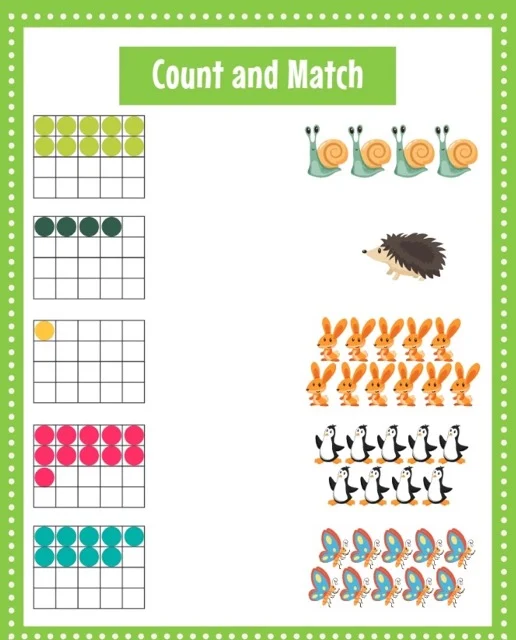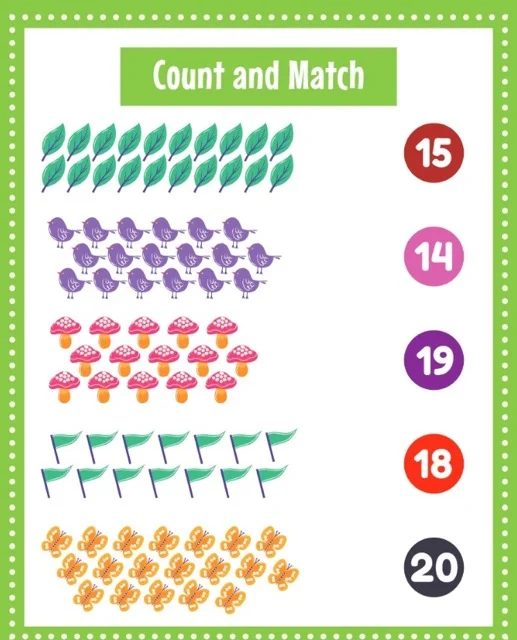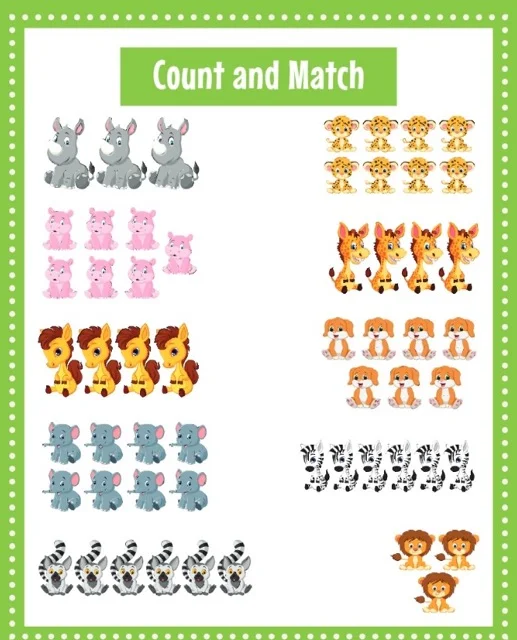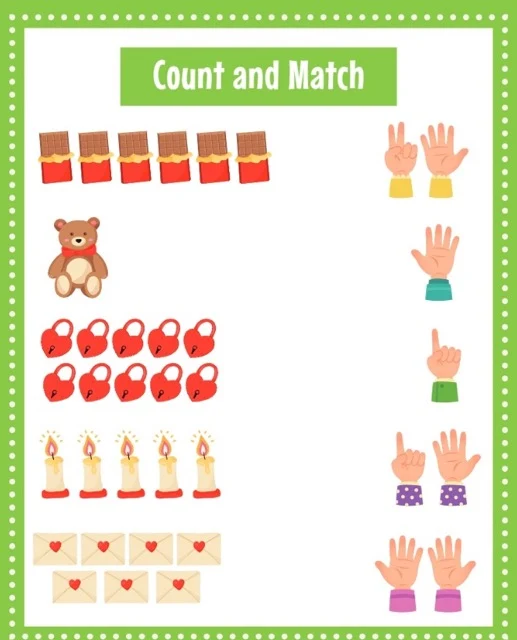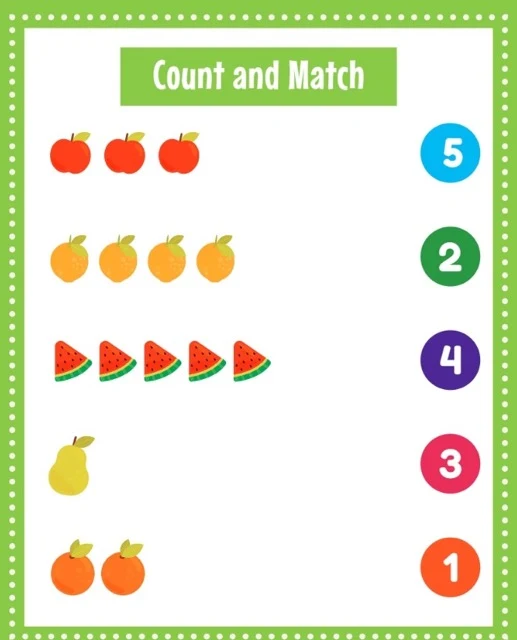Count and Match: A Preschool Math Guide
The document is a comprehensive guide to "Count and Match" exercises for preschool and kindergarten children. These exercises build foundational math skills, including counting, number recognition, one-to-one correspondence, and matching. The guide details various formats for these exercises, from object counting to using ten frames, and suggests ways to adapt them to different learning styles. Furthermore, it highlights the benefits beyond math skills, such as improved fine motor skills and concentration. Finally, it suggests resources to help implement these exercises effectively.Count and Match Exercises: A Comprehensive Guide
Count and Match Exercises: A Detailed Briefing
This document reviews the main themes and important facts about "Count and Match" exercises, drawing from provided source materials.
Core Objectives and Target Age Group
"Count and Match" exercises primarily aim to develop four core early math skills:
●
Counting: Accurately enumerating items in a set.
●
Number Recognition: Identifying and naming numerical values.
●
One-to-One Correspondence: Grasping that each counted object is paired with a single, unique number.
●
Matching: Connecting a counted quantity to its corresponding numerical representation.
These exercises are particularly beneficial for preschool and kindergarten children as they embark on learning fundamental math concepts.
Variety and Adaptability of Exercises
"Count and Match" exercises are incredibly versatile. Common formats include:
●
Object Counting: Counting images of objects and matching them to the correct numeral.
●
Pattern Matching: Identifying and counting recurring patterns.
●
Color and Quantity Association: Counting objects grouped by color and matching them to the right number and color combination (as seen in the provided "Testing Theme" document).
●
Ten Frames: Utilizing ten frames as a visual aid to represent numbers and practice counting to ten.
Beyond visual counting, these exercises can be adapted to include:
●
Auditory Counting: Counting sounds like claps and matching them to numbers.
●
Tactile Counting: Counting objects by touch and associating them with their numerical counterparts.
Effective Implementation Strategies
To maximize the effectiveness of "Count and Match" exercises:
●
Start with Simple Activities: Begin with smaller numbers and gradually increase complexity as the child progresses.
●
Encourage Interaction: Prompt children to point at each object as they count and verbalize the numbers.
●
Use Real Objects: Supplement visual exercises with tangible items like toys or blocks for hands-on learning.
●
Provide Positive Reinforcement: Celebrate children's efforts and successes to foster motivation and confidence.
Adapting to Different Learning Styles
"Count and Match" exercises can be modified to cater to various learning styles:
●
Incorporate Movement: Integrate physical activities like jumping, clapping, or stepping while counting.
●
Create Stories: Weave counting elements into storytelling to make learning more engaging and enjoyable.
●
Play Games: Transform exercises into simple board games or card games to add an element of fun and competition.
Benefits Beyond Counting Skills
In addition to developing counting skills, "Count and Match" activities can:
●
Enhance Fine Motor Skills: Manipulating small objects and pointing at images refine fine motor control.
●
Improve Visual Discrimination: Distinguishing between different objects and patterns sharpens visual perception.
●
Increase Concentration and Focus: Completing these tasks demands sustained attention, which fosters concentration skills.
Visual Aids
The provided "Testing Theme" document demonstrates the use of various visual aids in "Count and Match" exercises, including:
●
Pictures of Objects: Engaging images of everyday items and animals are used for counting and matching activities.
●
Colorful Arrays of Shapes: Various shapes arranged in patterns and groups provide visual stimulation and aid in counting and matching.
●
Ten Frames: Structured representations help visualize numbers and facilitate counting to ten.
Accessing Additional Resources
Numerous resources can support "Count and Match" learning:
●
Online Websites: Many websites offer printable worksheets and interactive games.
●
Educational Workbooks: Workbooks specifically designed for early math skill development are readily available.
●
DIY Activities: Simple "Count and Match" activities can be created using household items, stickers, or cut-outs.
Conclusion
"Count and Match" exercises are invaluable tools for building a strong foundation in early math. Their versatility, adaptability, and diverse benefits make them essential for fostering young children's mathematical understanding and setting them on a path towards future success in mathematics.
Count and Match: Early Math Skills Development
Count and Match: Frequently Asked Questions
1. What is the main objective of these "Count and Match" exercises?
The "Count and Match" exercises aim to help children develop essential early math skills. Specifically, they focus on:
●
Counting: Learning to count objects accurately.
●
Number Recognition: Recognizing and identifying numerical values.
●
One-to-One Correspondence: Understanding that each object counted gets paired with one number.
●
Matching: Connecting a counted quantity to its corresponding numerical representation.
2. What age group are these exercises most suitable for?
These exercises are best suited for preschool and kindergarten children who are beginning to learn basic math concepts. However, older children struggling with counting and number recognition may also benefit from these activities.
3. What variety of activities are included in "Count and Match"?
"Count and Match" exercises come in different formats to keep learning engaging. Some common types include:
●
Object Counting: Counting various pictures of objects and matching them to the correct number.
●
Pattern Matching: Identifying and counting repeating patterns of shapes or objects.
●
Color and Quantity Association: Counting objects grouped by color and matching them to the corresponding number and color combination.
●
Ten Frames: Using ten frames to visualize numbers and practice counting to ten.
4. Are these exercises only about visual counting?
While the provided examples mainly focus on visual counting, "Count and Match" activities can be adapted to include:
●
Auditory Counting: Counting sounds like claps or beats and matching them to numbers.
●
Tactile Counting: Counting objects by touch and associating them with numbers.
5. How can these exercises be used effectively at home or in the classroom?
Here are some tips for using "Count and Match" exercises:
●
Start with Simple Activities: Begin with activities involving smaller numbers and gradually increase complexity.
●
Make it Interactive: Encourage children to point at each object as they count and say the numbers aloud.
●
Use Real Objects: Supplement the exercises with real-life objects like toys or blocks for hands-on counting.
●
Positive Reinforcement: Praise children for their efforts and celebrate their successes.
6. Can these exercises be adapted for different learning styles?
Absolutely! The concept of "Count and Match" is versatile. You can:
●
Use Movement: Incorporate movement by having children jump, clap, or take steps while counting.
●
Create Stories: Weave counting into storytelling activities to make learning more enjoyable.
●
Play Games: Adapt the exercises into simple board games or card games.
7. Are there any additional benefits to these types of activities beyond counting skills?
Yes, "Count and Match" exercises can also help develop:
●
Fine Motor Skills: Manipulating small objects or pointing at pictures refines fine motor control.
●
Visual Discrimination: Distinguishing between different objects and patterns enhances visual perception.
●
Concentration and Focus: Completing these activities requires sustained attention, promoting focus.
8. Where can I find more "Count and Match" resources?
●
Online Resources: Websites offering printable worksheets and interactive games are readily available.
●
Educational Workbooks: Look for workbooks specifically designed for early math skills development.
●
DIY Activities: Create your own "Count and Match" activities using household items, stickers, or cut-outs.
Count and Match Mastery: A Study Guide
Count and Match Mastery: A Study Guide
Quiz
Instructions: Answer the following questions in 2-3 sentences each.
1.
What are the four core early math skills that "Count and Match" exercises aim to develop?
2.
Describe two different formats of "Count and Match" exercises.
3.
Beyond visual counting, how can "Count and Match" activities be adapted to incorporate other sensory experiences?
4.
Provide three tips for effectively using "Count and Match" exercises at home or in a classroom setting.
5.
How can "Count and Match" exercises be modified to cater to different learning styles? Give two examples.
6.
Besides counting skills, what other developmental benefits can children gain from engaging in "Count and Match" activities? List three.
7.
Explain the concept of one-to-one correspondence and its significance in early math learning.
8.
Based on the provided document excerpts, identify three types of visual aids commonly used in "Count and Match" exercises.
9.
What age group is considered most suitable for "Count and Match" activities, and why?
10.
Where can educators and parents find additional "Count and Match" resources? Suggest three sources.
Quiz Answer Key
1.
"Count and Match" exercises aim to develop counting, number recognition, one-to-one correspondence, and matching skills.
2.
Two different formats include object counting, where children count pictures of objects and match them to numbers, and pattern matching, where they identify and count repeating patterns.
3.
"Count and Match" can involve auditory counting, where children count sounds, and tactile counting, where they count objects by touch.
4.
Effective tips include starting with simple activities, making it interactive by encouraging children to verbalize and point, and using real objects to supplement visual exercises.
5.
Adaptations can include incorporating movement while counting and creating stories that integrate counting elements.
6.
Additional benefits include improved fine motor skills, enhanced visual discrimination, and increased concentration and focus.
7.
One-to-one correspondence is the understanding that each object counted is paired with one unique number, forming the foundation for accurate counting.
8.
Common visual aids include pictures of objects, ten frames, and colorful arrays of shapes or items.
9.
The most suitable age group is preschool and kindergarten, as children in this stage begin to grasp basic math concepts.
10.
Additional resources can be found through online websites, in educational workbooks, and through DIY activities using everyday materials.
Essay Questions
1.
Discuss the importance of "Count and Match" activities in building a strong foundation for future mathematical understanding.
2.
Explain how "Count and Match" exercises can be used to assess a child's early math development and identify any potential areas of difficulty.
3.
Analyze the role of play-based learning in the context of "Count and Match" exercises. How can these activities be made fun and engaging for young children?
4.
Describe how technology can be incorporated into "Count and Match" activities to enhance learning and motivation. Discuss potential benefits and drawbacks.
5.
Considering the principles of differentiated instruction, propose strategies for adapting "Count and Match" exercises to meet the diverse needs of learners in an inclusive classroom setting.
Glossary of Key Terms








